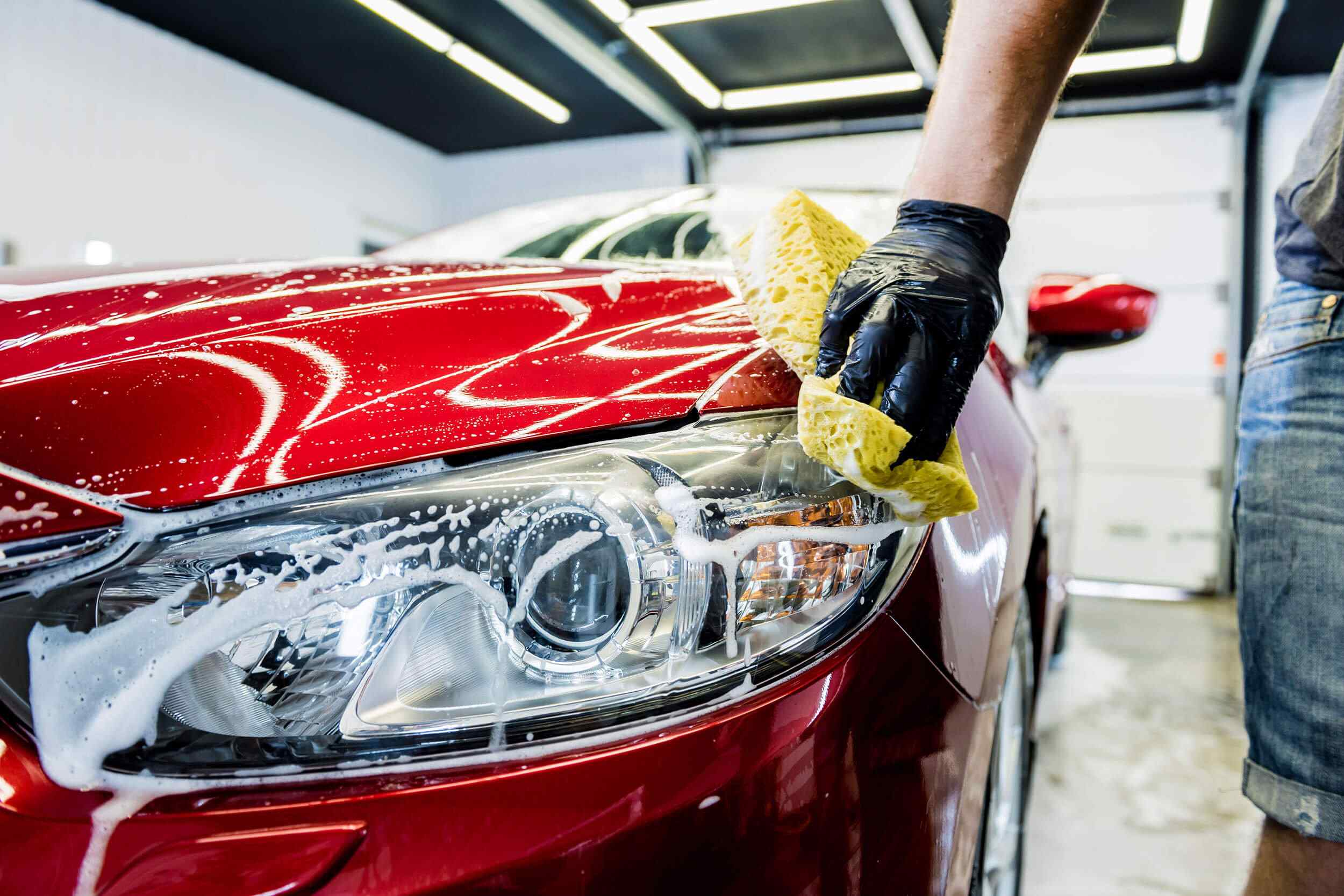Ceramic coating has become increasingly popular in the car detailing industry due to its ability to provide long-lasting protection and enhance the appearance of vehicles. This innovative technology offers a range of benefits that go beyond traditional waxing or sealants. In this article, we will explore what ceramic coating is, how it works, and why it is beneficial for your car. We will also discuss the different types of ceramic coating, the application process, and how to maintain it for optimal results.
Key Takeaways
- Ceramic coating is a liquid polymer that is applied to the exterior of a car to protect it from environmental damage.
- Benefits of ceramic coating include protection from UV rays, scratches, and chemical stains, as well as a glossy finish.
- Before applying ceramic coating, it is important to thoroughly wash and decontaminate the car's surface.
- There are different types of ceramic coating, including professional-grade and DIY options, and it is important to choose the right one for your needs.
- While ceramic coating can be applied by a professional or as a DIY project, it is important to properly maintain it to ensure its longevity.
What is Ceramic Coating and How Does it Work?
Ceramic coating is a liquid polymer that is applied to the exterior of a vehicle to protect its paint from various environmental contaminants. It forms a strong bond with the surface, creating a protective layer that is resistant to UV rays, scratches, and chemical stains. Unlike traditional wax or sealants, ceramic coating does not wash away or break down over time. It provides a long-lasting barrier that helps maintain the shine and gloss of your car's paint.The key to ceramic coating's effectiveness lies in its composition. It contains nanoparticles that fill in the microscopic pores of the paint, creating a smooth and hydrophobic surface. This hydrophobicity repels water and prevents dirt, dust, and other contaminants from adhering to the surface. As a result, your car stays cleaner for longer periods of time and requires less frequent washing.
The Benefits of Ceramic Coating for Your Car
One of the main benefits of ceramic coating is its ability to protect your car's paint from UV rays, which can cause fading and oxidation over time. The ceramic layer acts as a shield against harmful UV radiation, preventing damage to the underlying paint and keeping your car looking vibrant and new.In addition to UV protection, ceramic coating also provides a high level of scratch resistance. The hard and durable nature of the coating helps prevent swirl marks and fine scratches that can occur during regular washing or from contact with abrasive materials. This means that your car's paint will stay in pristine condition for longer, reducing the need for costly paint correction in the future.Another advantage of ceramic coating is its ability to repel chemical stains. The hydrophobic properties of the coating make it difficult for contaminants such as bird droppings, tree sap, and road tar to bond with the surface. This makes cleaning your car much easier and reduces the risk of permanent damage to the paint.
How to Prepare Your Car for Ceramic Coating
| Step | Description |
|---|
| 1 | Wash your car thoroughly to remove any dirt or debris. |
| 2 | Clay bar your car to remove any contaminants that washing may have missed. |
| 3 | Polish your car to remove any swirl marks or scratches. |
| 4 | Apply a surface prep solution to remove any remaining oils or residue. |
| 5 | Apply the ceramic coating in a well-ventilated area and follow the manufacturer's instructions. |
| 6 | Allow the coating to cure for the recommended time before exposing it to water or other elements. |
| 7 | Maintain the coating by washing your car regularly and avoiding harsh chemicals or abrasive materials. |
Before applying ceramic coating, it is important to properly prepare your car's surface to ensure optimal results. This involves a series of steps that include washing, decontamination, paint correction, and surface preparation.First, you should thoroughly wash your car to remove any dirt, grime, or loose particles that may be present on the surface. Use a pH-neutral car shampoo and a microfiber wash mitt to avoid scratching the paint. Rinse the car thoroughly and dry it using a clean microfiber towel.Next, you need to decontaminate the paint to remove any embedded contaminants such as tar, tree sap, or industrial fallout. This can be done using a clay bar or a dedicated decontamination product. Simply lubricate the surface with a clay bar lubricant or decontamination spray and gently glide the clay bar over the paint. This will help remove any bonded contaminants and leave the surface smooth and clean.After decontamination, you may need to perform paint correction if there are any swirl marks, scratches, or imperfections on the paint. This can be done using a dual-action polisher and appropriate polishing compounds. The goal is to restore the paint's clarity and remove any defects before applying the ceramic coating.Once the paint is clean and free of imperfections, it is important to prepare the surface for ceramic coating application. This involves using a surface preparation product such as a panel wipe or isopropyl alcohol to remove any remaining residues and ensure a clean and smooth surface for the coating to bond to.
The Different Types of Ceramic Coating and Which One is Right for You
There are several different types of ceramic coating available on the market, each with its own unique characteristics and benefits. The most common types include SiO2 (silicon dioxide) coatings, SiC (silicon carbide) coatings, and hybrid coatings.SiO2 coatings are the most popular and widely used type of ceramic coating. They provide excellent hydrophobicity, UV protection, and chemical resistance. SiO2 coatings are known for their durability and can last anywhere from 1 to 5 years depending on the quality of the product and how well it is maintained.SiC coatings, on the other hand, offer superior scratch resistance and hardness compared to SiO2 coatings. They are often used in high-performance applications where maximum protection is required. SiC coatings can last up to 7 years or more with proper maintenance.Hybrid coatings combine the benefits of both SiO2 and SiC coatings, offering a balance between durability and scratch resistance. They are a popular choice for those who want long-lasting protection without sacrificing performance.When choosing the right ceramic coating for your car, there are several factors to consider. These include your budget, desired level of protection, expected lifespan, and ease of application. It is also important to read reviews and do research on different brands to ensure you are getting a high-quality product that will deliver the desired results.
The Application Process: DIY or Professional Installation?
Once you have chosen the right ceramic coating for your car, you need to decide whether to apply it yourself or have it professionally installed. Both options have their pros and cons, so it ultimately depends on your level of experience, time availability, and budget.DIY ceramic coating application can be a cost-effective option if you are willing to put in the time and effort to learn the proper techniques. There are many online tutorials and guides available that can help you navigate the application process. However, it is important to note that ceramic coating application requires careful attention to detail and a certain level of skill to achieve optimal results. If you are not confident in your abilities or do not have the necessary tools, it may be best to leave it to the professionals.Professional installation offers several advantages, including expertise, experience, and access to professional-grade products and equipment. Professional detailers have the knowledge and skills to properly prepare the surface, apply the coating evenly, and ensure a flawless finish. They also have access to high-quality coatings that may not be available to the general public. While professional installation may be more expensive upfront, it can save you time and potentially costly mistakes in the long run.
How to Maintain Your Ceramic Coating
Once your ceramic coating is applied, it is important to properly maintain it to ensure its longevity and effectiveness. While ceramic coatings are highly durable, they are not completely maintenance-free. Here are some tips for maintaining the shine and protection of your ceramic coating:1. Regular washing: Wash your car regularly using a pH-neutral car shampoo and a microfiber wash mitt. Avoid using harsh chemicals or abrasive materials that can damage the coating.2. Use a dedicated ceramic coating maintenance spray: There are specific maintenance sprays available that are designed to enhance the hydrophobic properties of ceramic coatings and provide additional protection. These sprays can be applied after washing or as a quick detailer between washes.3. Avoid automatic car washes: Automated car washes often use harsh chemicals and brushes that can scratch or damage the coating. It is best to hand wash your car or use touchless car washes that do not come into contact with the paint.4. Dry your car properly: After washing, use a clean microfiber towel or a drying aid to dry your car. This will help prevent water spots and mineral deposits from forming on the surface.5. Avoid parking under trees or in direct sunlight: Tree sap, bird droppings, and UV rays can damage the coating over time. Whenever possible, park your car in a shaded area or use a car cover for added protection.6. Regular inspections: Inspect your ceramic coating periodically for any signs of wear or damage. Look for areas where the hydrophobicity has diminished or where water no longer beads on the surface. If you notice any issues, it may be time to reapply the coating.
Common Mistakes to Avoid When Applying Ceramic Coating
While ceramic coating application is relatively straightforward, there are some common mistakes that can ruin the process and compromise the results. Here are some tips for avoiding these mistakes:1. Insufficient surface preparation: Properly preparing the surface is crucial for the coating to bond effectively. Make sure to thoroughly wash, decontaminate, and polish the paint before applying the coating.2. Applying too much product: More is not always better when it comes to ceramic coating. Applying too much product can lead to streaks, high spots, and an uneven finish. Follow the manufacturer's instructions and apply the coating in thin and even layers.3. Not allowing enough curing time: Ceramic coatings require a certain amount of time to cure and bond with the paint. It is important to follow the recommended curing time before exposing the car to water or other elements.4. Not maintaining proper temperature and humidity levels: Temperature and humidity can affect the application and curing process of ceramic coatings. Make sure to apply the coating in a controlled environment with optimal conditions for best results.5. Not wearing protective gear: Ceramic coatings contain chemicals that can be harmful if they come into contact with your skin or eyes. Always wear gloves, goggles, and a mask when applying the coating to protect yourself.
How Long Does Ceramic Coating Last and When Should You Reapply?
The lifespan of ceramic coating can vary depending on several factors, including the quality of the product, how well it is maintained, and the environmental conditions it is exposed to. On average, ceramic coatings can last anywhere from 1 to 5 years. Some high-quality coatings can even last up to 7 years or more with proper care.It is important to keep in mind that ceramic coatings do not last forever and will eventually wear off over time. Signs that it's time to reapply the coating include diminished hydrophobicity, decreased gloss and shine, and increased susceptibility to scratches and stains. Regular inspections and maintenance will help you determine when it is time for reapplication.
Ceramic Coating vs. Traditional Waxing: Which is Better?
When it comes to protecting your car's paint, there has always been a debate between ceramic coating and traditional waxing. Both methods have their own benefits and drawbacks, so it ultimately depends on your personal preferences and needs.Traditional waxing offers a temporary layer of protection that enhances the shine and gloss of your car's paint. It provides a sacrificial barrier against UV rays, water spots, and light scratches. However, waxing needs to be reapplied every few months as it breaks down over time and is easily washed away by rain or regular washing.Ceramic coating, on the other hand, offers a more durable and long-lasting solution. It provides superior protection against UV rays, scratches, chemical stains, and other environmental contaminants. Ceramic coatings can last for several years with proper maintenance and do not require frequent reapplication like waxing.While ceramic coating offers many advantages over traditional waxing, it is important to note that it is a more involved and expensive process. Ceramic coating requires proper surface preparation, application techniques, and curing time. It also requires more upfront investment compared to waxing. However, the long-term benefits and protection provided by ceramic coating often outweigh the initial cost and effort.
Frequently Asked Questions About Ceramic Coating
1. Is ceramic coating worth it?Yes, ceramic coating is worth it for those who want long-lasting protection and enhanced appearance for their car. It offers superior protection against UV rays, scratches, and chemical stains compared to traditional waxing or sealants.2. Can I apply ceramic coating myself?Yes, you can apply ceramic coating yourself if you have the necessary tools, knowledge, and patience. However, it is important to follow the manufacturer's instructions and take the time to properly prepare the surface for optimal results.3. How long does ceramic coating last?The lifespan of ceramic coating can vary depending on several factors, but on average it can last anywhere from 1 to 5 years. Some high-quality coatings can last up to 7 years or more with proper maintenance.4. Can I wax over ceramic coating?It is not necessary to wax over ceramic coating as it already provides a protective layer. Waxing over ceramic coating may not provide any additional benefits and can potentially interfere with the hydrophobic properties of the coating.5. Can I apply ceramic coating on a new car?Yes, you can apply ceramic coating on a new car to provide an extra layer of protection for the paint. However, it is important to properly wash and decontaminate the surface before applying the coating to ensure optimal bonding.In conclusion, ceramic coating is an innovative technology that offers superior protection and enhanced appearance for your car's paint. It provides long-lasting shine and gloss, while also protecting against UV rays, scratches, and chemical stains. Proper preparation and application are key to achieving optimal results, whether you choose to apply the coating yourself or have it professionally installed. With regular maintenance and care, ceramic coating can provide years of protection and keep your car looking its best. So, if you want to take your car's appearance to the next level and ensure its long-term protection, consider investing in ceramic coating.If you're interested in ceramic coating for your vehicle, you might also want to check out this article on Fleet Details about a car detailing shop that recently opened in Cherry Valley, IL, serving Rockford. They offer a range of services including ceramic coating to protect your car's paint and keep it looking shiny and new. You can read more about it
here.




